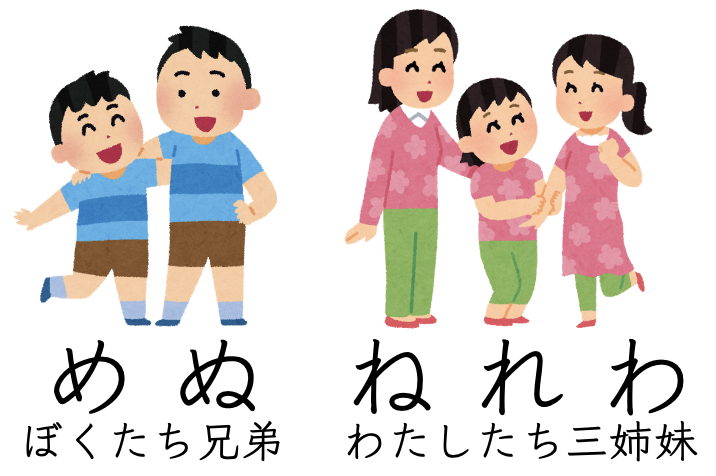前回に引き続き文字の書き方を教える時のポイントをまとめました。
Continuing from the previous post, here is a summary of the key points to consider when teaching Hiragana letters to primary students.
パート①では導入部分。今回のパート②では、小学生にひらがなを体系的に教える方法を紹介します。Part 1 was an introduction. In this Part 2, I will show you how to teach Hiragana to lower primary students in a systematic way.
1画のひらがなまでは簡単なんですが、2画からちょっと複雑になってきます。以外に2画のひらがなには難しいのが存在します。
It is easy to teach up to the first stroke of Hiragana, but it becomes a little more complicated from the second stroke. There are some difficult 2 strokes of Hiragana letters.
(記事の最後に画数色分けひらがな表フリーダウンロードあります。
Hiragana stroke colour coded chart at the end of this post)
め ぬ
れ わ ね
私は、これらを教える時に覚え易い様に物語を作ります。
When I teach them, I make up stories to make them easy to remember.
め ぬ →これらは兄弟。左から次男、長男。
These are brothers. From left to right: younger brother, older brother.
れ わ ね →これらは三姉妹。左から三女、次女、長女。
These are three sisters. From left to right: third, second and first sister.
この様に文字に親しみ易い関連性やストーリーを付けることで、これらの馴染みのない文字が子どもの世界観に溶け込み、頭に残りやすくなります。
By adding familiar concepts and stories to the Hiragana letters, these unfamiliar letters can be integrated into the child’s perspective of the world and remain in his or her mind.
「め」は弟でたくさん食べて大きくなったら、お兄ちゃんになってボールで遊べる「ぬ」になる。When “Me” grows up, he will become a big brother “Nu” and be able to play with a ball.
「れ」はもっとたくさん食べてまずは大きく風船みたいにならないと「わ」にはなれず、更に大きくなると「ね」になってボールを持って遊ぶことができるようになる。
When “Re” eats a lot more and grows bigger, she becomes “Wa” and when she grows up, even more, she becomes “Ne” then can play with a ball.
と、大人が聞くと?????なんじゃ?
ってなるストーリーですが、子どもは目を輝かせながら聞いている。そして、その瞬間に自分の社会と関連付け覚えられるという事です。
And when adults hear this story, ????? What is it?
The story makes you wonder, but the child listens with a sparkle in his or her eyes. And that moment, they can relate it to their own world so they can remember it.
勿論、話は脱線しますよ。
口々に、私は妹がいるから『ね』なんだよー、とか、
僕は弟だから『ぬ』になるねー、とか、
となると、今週末はお兄ちゃんの誕生日なんだ〜、とか、
僕は、兄弟がいなーい、とか(この場合は、似たひらがな文字がない『あ、ふ、な』などを例にあげて、スペシャルであることを強調)
Of course, the class gets sidetracked.
They say things like, “I have a younger sister, so I’m a ‘ne’.
I’m a little brother, so I’ll be “Nu”…” and so on.
Then, this weekend is my brother’s birthday…
I don’t have any siblings,” etc. (In this case, the special is emphasized by giving examples such as “A, F, Na,” which have no similar hiragana characters).
てな感じで、進みます。イントロなので、次回までにひらがなって家族なんだ〜って覚えてもらえたらそれでオッケー。
And so it goes on. Since this is an intro, it is OK if the students remember that Hiragana letters are big family by the next lesson.
なんてことないですが、機械的に学ぶよりもなんか楽しくないですか?
私は、幼児教育が専門なので「遊びながら学ぶ」というのをモットーに教えたいと日頃から思い実践しています。
It’s a simple method, but isn’t it more fun than learning mechanically?
Since I specialise in early childhood education, I have always wanted to teach with the motto of “learning through play” and practice it on a daily basis.
兄弟、姉妹、従兄弟、叔父、叔母、などなど家族フル出演でひらがなを覚えます。
結局、ひらがなは大きな家族なんです。チャンチャンという具合になる。
Brothers, sisters, cousins, uncles, aunts, etc., all family members perform to learn hiragana. After all, hiragana is a big family.
Happy end.

ひらがな大家族(番外編)Hiragana Big Family (Extra)
『し、つ』『く、へ』『い、こ』→双子 Twins
『い、り』『た、に』『う、つ』『は、ほ』→いとこ Cousins
『ろ』『る』→姉妹 Sisters/Brothers
『あ、ふ、ゆ、日、背、な、み』→ 一人っ子ちゃん Only child
ひらがな筆順カラーフリーダウンロード。Free Hiragana stroke colour coded material download.


